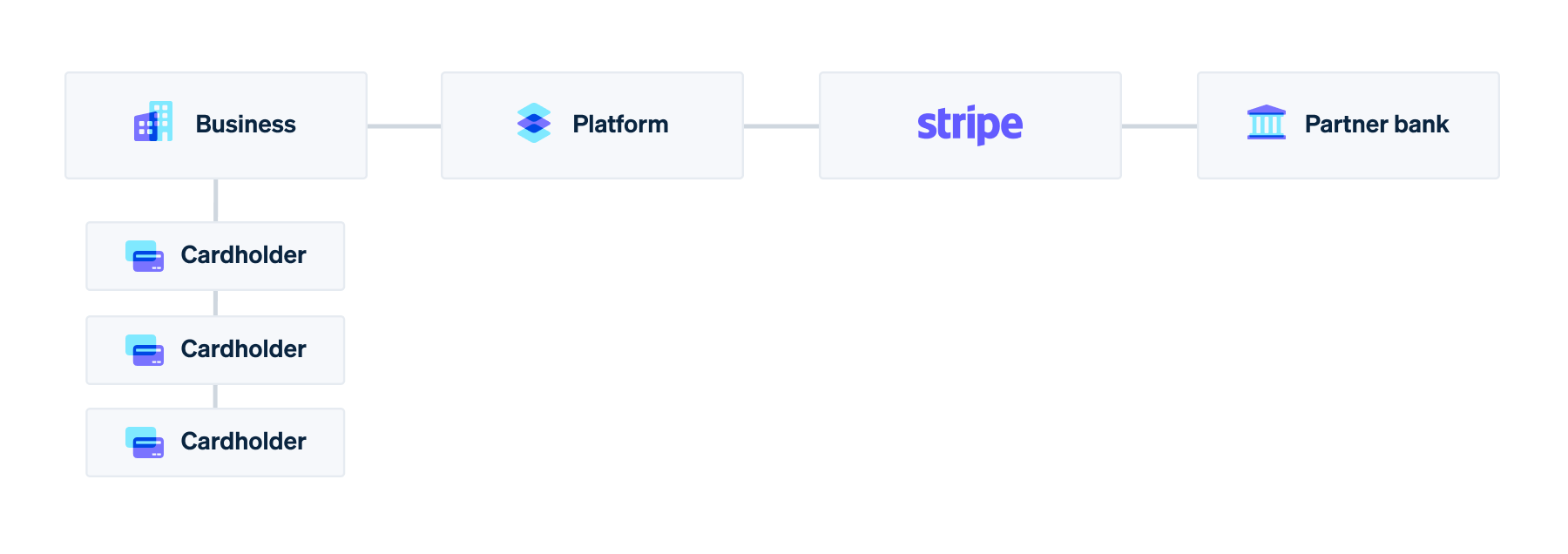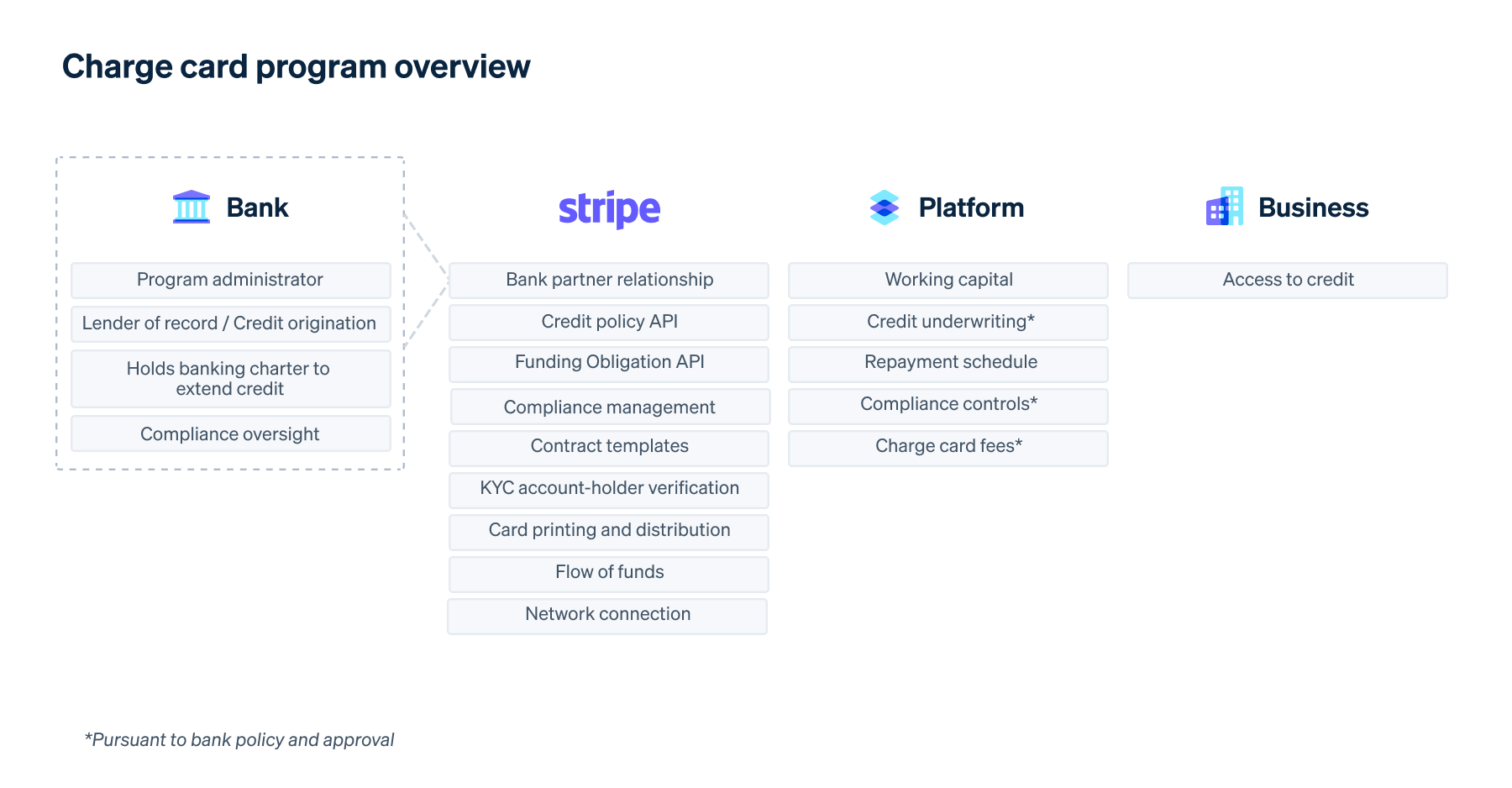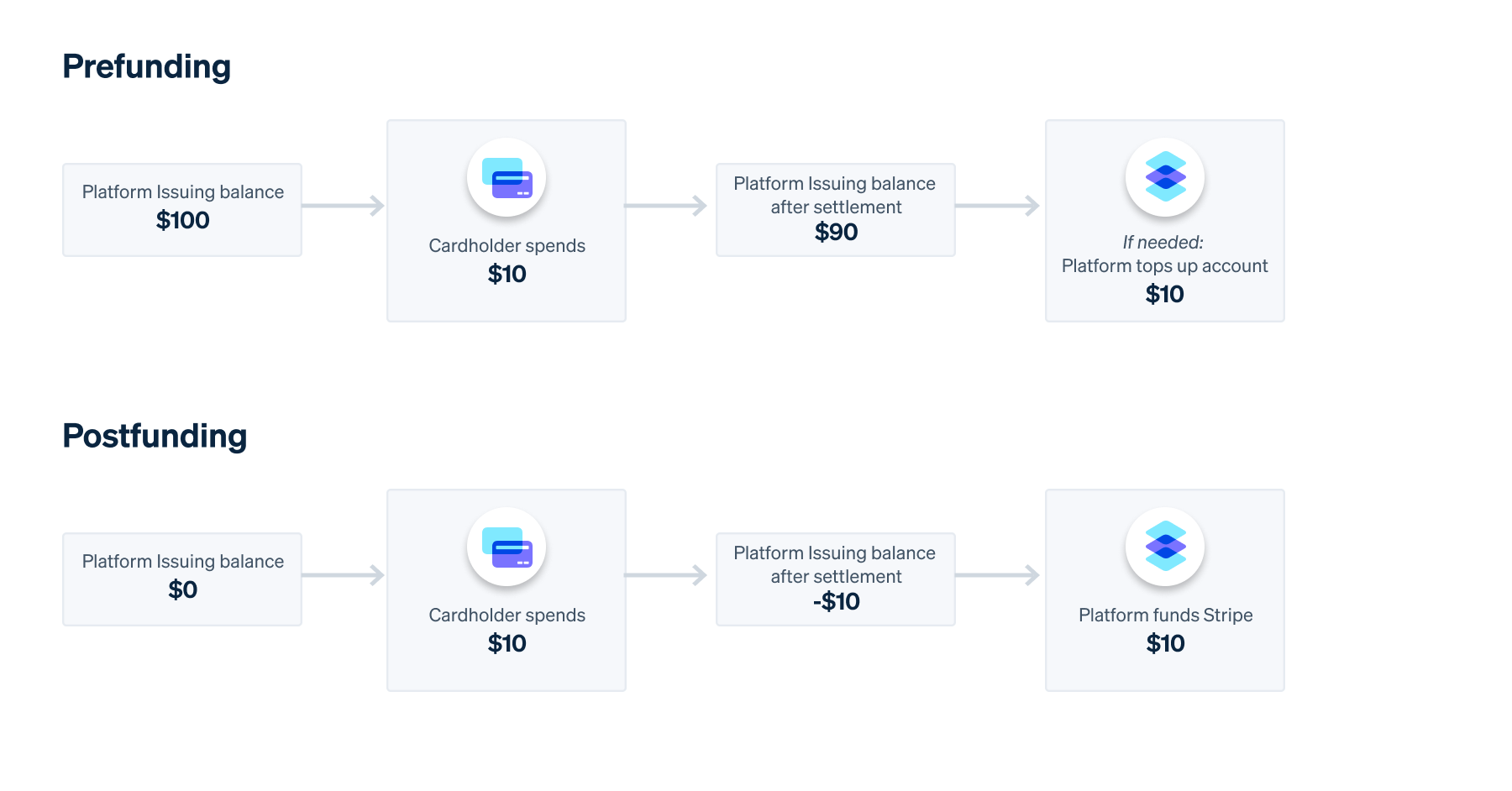プラットフォームが製品の粘着性を向上させたい場合でも、新しい収入源を開拓することに関心がある場合でも、チャージカードの提供は事業の魅力的な部分となり得ます。チャージカードプログラムを使用すると、アカウント所有者は利用可能な資金よりも早く支出し、資金が使用された後にプラットフォームに返済できます。
チャージカードは紙の上では素晴らしいように聞こえますが、プログラムの構築は難しい場合があります。プラットフォームは、カードへの資金調達方法、返済回収方法、融資法令遵守の処理方法などについて考える必要があります。幸いなことに、Stripe のような BaaS (Banking-as-a-Service) プロバイダーが役に立ちます。
最高レベルでは、BaaS プロバイダーは、チャージカードプログラムのインフラストラクチャとロジスティクスをフィンテックやソフトウェア会社などのプラットフォームに拡張します。次に、プラットフォームは基盤となる BaaS インフラストラクチャを使用して、顧客にチャージカードを提供します。たとえば、Stripe Issuing には、Ramp が事業顧客にチャージカードを提供するために使用するチャージカードプログラムがあります。多くの場合、プラットフォームは、チャージカードを使用すると顧客が信用枠で支出できるため、経費管理ソリューションの一部としてチャージカードを提供したいと考えています。
このガイドでは、チャージカードとは何か、チャージカードが役立つ理由、チャージカードプログラムを選択する際に考慮すべき点について説明します。このガイドは、対象となる金融サービスと商品がヨーロッパとアジア太平洋地域で異なる動作をするため、アメリカを拠点とする顧客にサービスを提供するアメリカのプラットフォームを対象としています。
以下は一般的な情報と教育を目的としており、Stripe の経験と市場観察に基づいています。このガイドは法的アドバイスを構成するものではなく、顧客にチャージカードを提供する前に、固有の状況について弁護士に確認する必要があります。
チャージカードとは?
チャージカードは概念的にはクレジットカードに似ており、アカウント所有者は利用可能な資金よりも先に支出し、資金が使用された後にプラットフォームに返済できます。言い換えれば、どちらのカードでも、アカウント所有者は信用枠にお金を使うことができます。
ただし、チャージカードとクレジットカードには 2 つの重要な違いがあります。チャージカードの場合。1) カード会員は支払い期間の終了時に残高をロールオーバーすることができず、2) カード会員は未払い残高に対して利息を蓄積することはできません。チャージカードは、支払い期間の終了時に全額支払う必要があります。カード会員が期日までに残高を全額支払わなかった場合、延滞料やその他の形の違約金が発生する可能性があります。
チャージカードもプリペイドカードやデビットカードとは異なります。プリペイドカードとデビットカードは、常に資金を保持する口座に添付されます。プリペイドカードまたはデビットカードでは、アカウント所有者は、カードに関連付けられたアカウントに保存されている資金の金額までしか使用できません。このため、アカウント所有者は経費を計上して後で返済することはできません。取引を成功させるには、カードに十分な資金がすぐに利用できるようにする必要があります。
ほとんどのプラットフォームは BaaS インフラストラクチャを使用して、チャージカードまたはプリペイド / デビットカードのいずれかを提供します。
|
クレジットカード
|
支払いカード
|
クレジットカードまたはデビットカード
|
|
|---|---|---|---|
|
仕組み
|
カード保有者は信用限度枠内で支出することができます。 | カード保有者は信用限度枠内で支出することができます。 | カード保有者はすぐに利用可能な保管金の範囲内で支出することができます。 |
|
返済
|
取引発生後に返済を行います。利息を適用して返済を次の支払いに繰り越すことができます。 | 取引発生後に返済を行います。返済を次の支払いに繰り越すことはできません。 | 該当なし。返済はありません。カード保有者が利用可能な金額を超えて支出することはできません。 |
チャージカードプログラムの仕組み
チャージカードの提供の詳細に入る前に、BaaS チャージカードプログラムがどのように機能し、どのエンティティが関与しているかを大まかに理解しておくと役立ちます。

- カード会員: カードを使用して企業に代わって購入を行う企業の担当者。各事業に 1 人または複数のカード会員がいる場合があります。たとえば、独立して事業を運営している個人事業主と協力している場合、各事業にカード会員は 1 人しかいない可能性があります。複数の従業員を抱える中小企業と協力している場合、事業での購入にカードを必要とするカード会員が複数いる場合があります。
- 事業: プラットフォームの顧客とカードアカウント所有者。企業はプラットフォームのソフトウェアを使用し、プラットフォームは製品の一部としてカードへのアクセスを企業に提供します。企業は、引受基準によって決定される特定の与信限度額まで支出できます。1
- プラットフォーム: 企業にカードへのアクセスを提供したい企業。プラットフォームは、フィンテック企業、ソフトウェアプラットフォーム (垂直 SaaS 企業など)、または別の種類の企業である可能性があります。このプラットフォームは、BaaS プロバイダーと連携して、事業顧客向けのカードサービスを作成します。
- BaaS プロバイダー: パートナー銀行と協力してプラットフォームが使用するカードプログラムを構築するノンバンク (Stripe など)。BaaS プロバイダーは、パートナー銀行に代わって取引を承認または拒否し、カード会員データの記録システムを維持し、ネットワークと決済を通信します。その法令遵守チームはプラットフォームと協力してパートナー銀行の法令遵守要件を実装し、プラットフォームが継続的な法令遵守について定期的に監視しています。
- パートナー銀行: 連邦または州が公認した銀行。1 つの BaaS プロバイダーがプログラムのために複数のパートナー銀行と連携する場合があり、BaaS チャージカードプログラムの構成に応じて、パートナー銀行は次のサービスのいずれかまたは両方を提供します。
- カードネットワークのメンバーとして決済カード (クレジットカード、デビットカード、プリペイドカードなど) を発行する
- 事業アカウント所有者のクレジットを発行し、BaaS プロバイダーによって実装および監視される法令遵守要件を定義します
- カードネットワークのメンバーとして決済カード (クレジットカード、デビットカード、プリペイドカードなど) を発行する
一部のプラットフォームでは、パートナー銀行と直接連携し、BaaS プロバイダーをバイパスすることを選択する場合があります。詳細については、貸付プログラムのベストプラクティス を参照してください。
チャージカードを提供するメリット
一般に、顧客にカードを提供することには、プリペイドかクレジットの延長かにかかわらず、いくつかの利点があります。
- インターチェンジ収入の獲得: カード会員がカードサービスを通じて発行されたカードで購入するたびに、インターチェンジの一部を維持する ことで収入を得ることができます。これは、すべてのカード取引に伴うコストです。プラットフォームは、獲得したインターチェンジ収入の一部をポイント、「キャッシュバック」、またはその他の報酬の形で顧客と共有することを選択できます。
- トランザクションインサイトへのアクセス: プラットフォームは支出データにアクセスでき、経常経費の期限や成長傾向などの専有情報が得られます。Ramp などの支出管理プラットフォームは、カード取引データを使用して、顧客に自社の支出傾向に関する洞察を提供し、コスト削減の機会を示します。
- 新製品の提供: カードがコア製品の一部でない場合は、製品スイートを強化する方法としてカードを提供できます。たとえば、サロンや理髪店に予約ソフトウェアと支払い処理を提供するソフトウェアプラットフォームでは、企業が経費を管理する方法としてチャージカードを追加する場合があります。詳細
チャージカードを具体的に提供すると、次のような利点があります。
- 運転資金へのアクセスの拡大: チャージカードやクレジットカードの取得は面倒な場合があり、資本、連帯保証人、または堅牢な財務諸表が必要になる場合があります。実際、多くの新興企業や中小企業の経営者は、初期の会社支出を個人的に保証する必要があります。スタートアップのオーナーを対象とした Stripe の調査では、22% が個人カードではなく「事業用クレジットカードの使用を好む」と回答しました。2 プラットフォームは、企業に直接運転資金を提供することで、このギャップを埋めることができます。
- カスタマイズされた融資オファーの構築: プラットフォームは、処理する決済に基づいて企業の財務履歴を完全に理解しており、プレシードの新興企業であろうと地元の美容機関であろうと、サービスを提供する特定の業界の事業トレンドと典型的な資本ニーズを本質的に理解しています。プラットフォームがこれらの洞察を BaaS プロバイダーおよびそのパートナー銀行のインフラストラクチャと組み合わせることで、ユーザーに合わせた金融体験を提供できます。
チャージカードサービスを構築する
チャージカードを提供する前に、市場投入までのスピードとユーザーエクスペリエンスに影響を与える可能性のある 2 つの重要な決定事項、つまり融資の設定方法と返済の回収方法があります。
融資プログラムのベストプラクティス
規制要件に準拠するのが難しい場合があり、これは融資コンポーネントがあるチャージカードに特に当てはまります。
適用される法律や規制に従って、与信を延長するためにチャージカードサービスを設定することが重要です。フィンテックプラットフォームを構築するには法令遵守が不可欠ですが、正しく行わなければ、せいぜい会社に損害を与える可能性のある多額の罰金に直面する可能性があります。最悪の場合、会社が閉鎖される可能性があります。
通常、プラットフォームは次のいずれかの方法で融資を設定しますが、ユースケースについては必ず弁護士に相談してください。
- 貸付ライセンスの取得: 貸付ライセンスなどの金融サービスライセンスは、通常、銀行チャーターを持つ機関に予約されている特定の限定的な活動を実行するための許可であり、プラットフォームは、融資ライセンスを必要とする州で融資ライセンスを取得することで、直接信用を提供できます。3 これらのライセンスの取得は、通常、時間と費用の点でリソースを大量に消費します。このプラットフォームは、連邦融資規制および州規制当局による監督の対象となります。
- 銀行と直接連携: このオプションを使用すると、プラットフォームは銀行と直接提携して融資資金を提供し、銀行が記録上の貸し手となり、銀行の API と直接統合できるようになります。その後、プラットフォームは銀行または BaaS プロバイダーなどの別のパートナーを介してカードを配布します。(銀行は厳密には貸付ライセンスを保有していませんが、それはノンバンクに適したものであるためです。代わりに、彼らの憲章により、ローンを延長することができます。)
- BaaS プロバイダーとの連携: このプラットフォームは、統合用の使いやすい API を提供する BaaS プロバイダーと連携し、パートナー銀行に代わって法的および法令遵守の監視をプログラム管理します。パートナー銀行は記録上の貸し手であり、プラットフォームは「売掛金」と呼ばれるものを購入することで「債権者」になることができます。売掛金を借金のようなものと考えれば、プラットフォームは BaaS プロバイダーを介して銀行から債務を購入し、プラットフォームはその債務を貸借対照表に記録します。プラットフォームは、債務の期限が到来するまで、顧客 (事業アカウント所有者) のためにその債務を「保持」します。その後、アカウント所有者はプラットフォームに支払い、借金を相殺します。
すべてのオプションにおいて、プラットフォームは銀行スポンサーからある程度の監視を受けていますが、監視のレベルはモデルによって異なる場合があることに注意することが重要です。
|
貸金業ライセンスを取得する場合
|
銀行と直接提携する場合
|
BaaS プロバイダーと提携する場合
|
|
|---|---|---|---|
|
プラットフォームの責任
|
アメリカのどの州でも、プラットフォームで貸金業を行うには、関連するライセンスを申請する必要があります。融資が始まると、プリペイドカードやデビットカードにその資金を移すことになります。さらに、カードを発行するために銀行や BaaS プロバイダーとの提携が必要になります。
プラットフォームはこの方法で信用を拡大できますが、カードに信用限度枠がないため、このサービスは厳密には支払いカードではありません。
|
プラットフォームは銀行と提携して、補償、宣伝、データの所有者やプライバシーなど、法的合意や契約事項について取り決めます。また、銀行の API と直接接続します。
さらに、プラットフォームは、銀行との関係を管理し、銀行の要件を満たすため、少なくとも 2 人の人員 (コンプライアンスマネージャーとプログラムマネージャー) を雇用することが求められます。このような銀行の要件としては、コンプライアンスに関する方針や手順の策定、従業員への教育訓練の実施、プラットフォームの金融サービスについて継続的な統制、リスク評価、検査および報告を行う体制の確立などが挙げられます。
|
プラットフォームの責任は BaaS プロバイダーによって異なります。
たとえば、Stripe の支払いカードプログラムの場合、プラットフォームは企業ごとにリスク評価基準の策定や信用限度額の設定を行いますが、Stripe がインフラストラクチャをすでに構築しているため、銀行スポンサーを手配する必要はありません。また、継続的な検査、教育訓練および報告によって提携銀行のコンプライアンス要件を遵守するにあたり、プラットフォームは Stripe と連携しなければなりません。
|
|
メリット
|
信用取引を始めるのは銀行ではないため、サービス全体がプラットフォームの管理下に置かれます。
|
プラットフォームは銀行と直接提携するため、貸金業ライセンスを取得する必要がありません。また、通常は、プラットフォームがサービス全体を比較的自由に管理できるほか、銀行と直接やり取りしてリスク評価プロセスを設計できます。
大規模プラットフォームの場合は、銀行と直接提携することでインターチェンジフィーのレベニューシェアが増える可能性があります。
|
BaaS プロバイダーの提携銀行と直接取引するため、プラットフォームは貸金業ライセンスを取得する必要がなく、提携先の銀行を探す必要もありません。BaaS プロバイダーを介することで、信用取引が可能な経費用カードを短期間で作成して提供できます。
プラットフォームは、BaaS プロバイダーから、ポリシー、テスト用リソースおよびコンプライアンスに関するサポートを受けたり、信用取引や帳簿作成、コンプライアンス、顧客確認 (KYC) および企業からの継続的な返済の処理に役立つ、使いやすい API や製品ソリューションの提供を受けたりすることのできます。
|
|
考慮事項
|
貸金業ライセンスを取得するプロセスは面倒な上、貸金業に関する要件は州によって異なります。通常、ライセンスが必要な州のライセンスを取得するには数年かかります。
準備が終わると、プラットフォームは規制監視の対象となりますが、適用要件は州によって異なります。そのほか、カードを発行した銀行パートナーや BaaS プロバイダーからもコンプライアンスの監視を受けることになります。
最後に、プリペイドカードやデビットカードを取り扱う場合、プラットフォームが受け取るインターチェンジ収益が低くなる可能性があります。
|
銀行と直接提携する場合は、導入費や管理費が高くなることが予想されます。準備にはかなりの時間がかかり、プラットフォームの規模によっては 12 カ月かかる場合もあります。
プラットフォームは、銀行との関係や継続的なコンプライアンス要件に対処するため、人員を増やすことを検討する必要もあります。
|
プラットフォームによる支払いカードの提供に適用されるクレジットポリシーとリスク評価は、BaaS プロバイダーと提携銀行による承認と監視の対象となります。クレジットポリシーの実施や適用はプラットフォームが管理するものの、クレジットポリシーの所有権は提携銀行に帰属し、提携銀行は (多くの場合、BaaS プロバイダーを介して) クレジットポリシーを監視します。
|
|
最適な企業
|
すでに貸金業ライセンスの取得作業を終えているプラットフォーム。 | 貸金業を主力商品としており、大規模なコンプライアンスチームと BaaS インフラストラクチャへの投資を予定しているプラットフォーム。 | スピーディーな市場投入を実現し、諸経費を最小限に抑えてサービスを推進したいと考えているプラットフォームや、貸金業を商品ラインアップに含めて企業に提供したいと考えているプラットフォーム。 |
マーチャントキャッシングについて: 一般的に言えば、マーチャントキャッシング (MCA) はローンではありません。代わりに、プラットフォーム (または「ファクタリング会社」) が割引と引き換えに潜在的な将来の収益から売掛金を購入することで、企業に将来の収益へのアクセスを提供できる従来のローンの代替手段です。その結果、企業は現在 (割引された) 現金にアクセスでき、時間の経過とともに収益を受け取るにつれてプラットフォームに返済する必要があります。MCA は一般的に、ローンよりもプラットフォームに多くの財務リスクを伴います。通常、事業の収益から直接引き出される売上の割合をプラットフォームに与えることで返済されます。ただし、事業が収益を生み出せない場合、プラットフォームは利益を完全に失います。このため、MCA は、通常、州ごとに、従来の融資とは異なる規制の対象となります。規制当局は、一部の企業が融資法を回避するために MCA を使用しているという事実に気づいているため、法令遵守の観点からも MCA はリスクがあることが判明する可能性があります。詳細については、弁護士にご相談ください。
返済の設定
チャージカードを介して資金を借りた後、企業は定期的に (通常は 15 日または 30 日ごと) 資金を返済する必要があります。チャージカードの場合、返済には通常、入金された金額と手数料の両方が含まれ、両方の合計は各支払いサイクルの終了時に支払われます。返済手続きでは、困難に対する特別な配慮を含め、予定された支払いを行えない場合に借り手が何をすべきかも明記する必要があります。
チャージカードのカード会員からの返済は、いくつかの方法で設定できますが、返済を回収する頻度と、返済の回収方法を決定する必要があります。
ユーザーから返済を回収する頻度は、運転資金、ユーザーが費やしている平均金額、およびユーザーの運転資本によって異なります。これらの設定は、BaaS プロバイダーの API から使用できる必要があります。たとえば、Stripe の API を使用すると、返済を毎週、毎月、毎月の特定の日 (毎月 15 日など)、または繰り返し 60 日ごとに行うように設定できます。
返済方法を選択するときは、カード会員が簡単に返済できることを確認してください。BaaS プロバイダーは、適用法に基づくベストプラクティスと一致する返済を簡単に回収するためのガイダンスとメカニズムを提供できる必要があります。たとえば、Stripe には Invoicing や Checkout のような一連の決済商品があり、プラットフォームの全体的な統合作業を最小限に抑えながら、返済金の回収が容易になります。
Stripe の支援方法
チャージカードオファリングを自分で設定するのは複雑で、時間とリソースを大量に消費します。これには、銀行パートナーの検索、複数の金融サービスライセンスの取得、法律専門家の雇用、カードの発行、および重要なエンジニアリングリソースの展開が含まれる場合があります。さらに、期限内に返済できない可能性のある企業の引受コストと経済的リスクは高くなる可能性があります。
幸いなことに、Stripe がお手伝いします。Stripe Issuing は、すでにカードの提供に関する多くのコンポーネント (銀行パートナーシップ、資金の流れ、規制と法令遵守のナビゲーション、ネットワーク接続、カードの印刷と配布、統合 API) を引き受けていますが、チャージカードを提供したいプラットフォームに特化した機能もあります。
- 法令遵守ファーストのチャージカードプログラム
- 資本効率の高い資金調達オプション
- 統合された返済オプション
Stripe Issuing のチャージカードプログラム
当社のチャージカードプログラムは、売掛金購入プログラムと API の 2 つの主要な部分で構成されています。
売掛金購入プログラム
当社の売掛金購入プログラム (RPP) は、当社の法務、法令遵守、融資ソリューションであり、プラットフォームが銀行パートナーを通じて企業にクレジットへのアクセスを提供できるようにします。当社のパートナー銀行は記録上の貸し手であり、プラットフォームは Stripe を介して銀行から売掛金を購入できます。当社の RPP により、プラットフォームは、融資ライセンスを取得したり、州固有のライセンス要件を独自にナビゲートしたりすることなく、企業にクレジットへのアクセスを提供できます。

プラットフォームは、法令遵守ポリシーなどの Stripe の法令遵守リソースを利用して、法令遵守に重点を置いたチャージカードサービスを設定および維持することもできます。当社のチームはプラットフォームと協力して、規制および提携銀行の要件に準拠したチャージカードサービスを設計しています。Stripe の法令遵守チームは、各プラットフォームのキックオフを行い、その後、一連のガイド付きチェックリストとディスカッションを行い、プラットフォームの提供するサービスに、銀行の最終的なレビューと承認のための適切なプロセス、開示、報告、管理がすべて整っていることを確認します。また、プラットフォームのリスクを継続的に管理し、パートナー銀行の継続的な監視の期待に応えるために、パートナー銀行に代わって定期的な報告とテスト活動を実施しています。
-
追加の融資ライセンスや銀行提携は必要ありません
-
50 州すべてで融資プログラムを提供する
-
堅牢な法令遵守リソースへのアクセス
当社の API
当社のクレジット API は、ユーザーごとに与信限度額と請求条件を設定でき、毎週、毎月などの柔軟な返済オプションをサポートします。プラットフォームは、1 回の API 呼び出しで、クレジットがどれだけ使われたかを手動で計算し、返金や異議申し立てを計上する代わりに、いつでも企業が支払うべき金額を取得できます。また、各アカウントのクレジット義務の管理にも役立ち、ユーザーが支出、返金を受け取ったとき、または異議申し立てに勝ったときに自動的に更新されます。プラットフォームはこの API を使用して、企業が提供したクレジットの量、企業による支出、返済額を追跡する台帳を作成および管理できます。
資本効率の高い資金調達オプション
プラットフォームが Stripe でチャージカードに資金を提供するには、プリファンディングとポストファンディングの 2 つの方法があります。
プリファンディングを使用すると、カード会員の将来の取引をカバーするために、プラットフォームのアカウントで資金をすぐに利用できます。ただし、ポストファンディングでは、カード会員の取引がキャプチャーされた後にのみ、プラットフォームがアカウントに資金を入金します。

一般に、ポストファンディングモデルは、プラットフォームが Stripe の口座に資金を保持する必要がなく、より多くの運転資金を提供するため、先払いよりも資本効率が高くなります。ほとんどのプラットフォームでは、ポストファンディングカードにより運転資金が 20% 以上改善されました。
|
事前資金調達
|
事後資金調達
|
|
|---|---|---|
|
メリット
|
これは、準備資金の調達を素早く簡単に行う方法として一般的です。Stripe では、事前資金調達に最低準備金を必要としません。Stripe で最も人気がある資金調達方法で、ほぼすべてのプログラムでこのオプションから始めることをお勧めします。 |
プラットフォームは口座に資金を入れておく必要がありません。そのため、支出額を予測する必要がなく、残高不足によって取引が拒否されることもありません。
また、多くの場合、事後資金調達の準備金として必要な資金は事前資金調達で必要となるバッファーよりも大幅に少ないため、プラットフォームの資本効率が向上します。
|
|
考慮事項
|
事前資金調達の場合、カード保有者の支出に対応できるよう十分な資金をプラットフォームの口座に入れておく必要があるため、予想金額が高くなる可能性があります。そのため、予期しない急増や多様な支出パターンを考慮する必要があります。取引の拒否が発生しないよう、十分と思われる金額よりも多めに資金を用意しておくことがベストプラクティスです。 | 事後資金調達の場合、準備に時間がかかり、追加のプログラムコストが発生します。他のフォワードフロー投資の手配と同様、通常、プラットフォームはキャッシュリザーブを計上する必要があります。 |
統合された返済オプション
プラットフォームは、当社の決済製品を使用して、全体的な統合作業を最小限に抑えながら、返済金の回収を容易にすることができます。
Stripe が現在提供している 2 つのコード不要の事前構築済み決済製品は、Checkout と Invoicing です。
- Stripe チェックアウト は、銀行口座を含むさまざまな決済方法による 1 回限りの決済または継続課金をサポートする、事前に構築されたオンラインの支払いページです。チェックアウトはコンバージョン用に最適化されており、企業は決済情報を簡単に再利用できます。企業は決済を行うためにプラットフォームのチェックアウトページにアクセスします。
- Stripe Invoicing は、コードなしで数分で企業に請求書を送信できます。また、売掛金の自動化、支払いの回収、取引の調整を行う高度な機能も備えています。Invoicing もコンバージョン用に最適化されており、請求書の 87% が 24 時間以内に支払われます。
プラットフォームは、Stripe 製品以外で返済を回収することもできます。
Stripe プラットフォーム全体へのアクセス
Stripe Issuing と Stripe のチャージカードプログラムに加えて、Stripe にはさまざまな方法で組み合わせることができる金融インフラ製品のエコシステム全体があります。
- Stripe Treasury は、ストアアンド支出アカウントや支出管理サービスなど、顧客向けにフル機能の金融商品を構築するための柔軟な BaaS API を提供します。Treasury を使用すると、金融口座の作成、資金の保管、当事者間の資金の移動、支出用のカードの添付などの中核となる構成要素が揃います。
- Stripe Capital は、Stripe Connect のプラットフォームにエンドツーエンドの融資 API を提供し、顧客の事業の成長を支援するために、迅速かつ柔軟な融資へのアクセスを提供します。Capital を使用すると、顧客は長い申請プロセスを行う必要がなく、返済は自動的に行われます。
- Stripe Connect を使用すると、マルチパーティ決済を埋め込み、顧客からの支払いの回収や第三者への支払いなど、さまざまな金融サービスを提供できます。プラットフォームは、提供されたサービスの料金を徴収することで収入を得ています。
- Stripe Financial Connections を使用すると、ユーザーが既存の金融口座を安全に接続し、財務データをプラットフォームと共有できるようにします。
- Stripe Identity を使用すると、グローバルユーザーの身元をプログラムで確認して、顧客確認 (KYC) 規制に準拠できます。
プラットフォームが Stripe を使用して顧客向けのチャージカードサービスを設定する方法について、詳細は Stripe チームまでお問い合わせください。
注意事項
- プラットフォームのチャージカードサービスの与信ポリシーと引受は、BaaS プロバイダーと提携銀行の承認と監督の対象となります。このプラットフォームは、BaaS プロバイダーおよびパートナー銀行と協力して、自社のリスク選好度に合わせた信用ポリシーを設計します。
- アメリカの 770+ 中小企業を対象に、商業銀行体験に関する Stripe Card 調査を実施しました。
- アメリカの多くの州では、ライセンスを取得しなくても、特定のパラメーター内で融資を行うことができます (金融手数料がない、または低い、商業団体に信用を提供するだけなど)。ただし、カリフォルニア州やネバダ州などの多くの大手市場では、融資ライセンス要件が厳しいため、このカテゴリーに該当しない可能性があります。詳細については、弁護士にご相談ください。